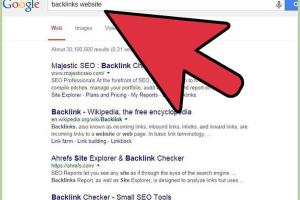6 Easy Steps to Add Backlinks to Your Website and Boost SEO

-
Quick Links:
- Step 1: Understand the Importance of Backlinks
- Step 2: Identify High-Quality Link Opportunities
- Step 3: Create Linkable Assets
- Step 4: Reach Out for Backlinks
- Step 5: Monitor Your Backlink Profile
- Step 6: Leverage Social Media and Content Marketing
- FAQs
Step 1: Understand the Importance of Backlinks
Backlinks, also known as inbound links, are links from one website to another. They play a crucial role in search engine optimization (SEO) because they signal to search engines that your content is valuable and credible. The more high-quality backlinks you have, the more likely your site will rank higher in search results.
According to a study by Moz, backlinks are one of the top three ranking factors in Google’s algorithm. This emphasizes the need to develop a robust backlink strategy for any website. Here’s why backlinks are important:
- Improve SEO Ranking: Backlinks improve your site's authority and ranking on search engines.
- Increase Referral Traffic: Backlinks can drive traffic from other websites to yours.
- Build Relationships: Building backlinks often involves networking with other content creators and businesses.
Step 2: Identify High-Quality Link Opportunities
Not all backlinks are created equal. Focus on acquiring links from high-authority websites that are relevant to your niche. Here are some strategies to find link opportunities:
- Competitor Backlink Analysis: Use tools like Ahrefs or SEMrush to analyze your competitors’ backlink profiles.
- Guest Blogging: Identify blogs that accept guest posts in your niche. This not only gives you a backlink but also introduces your brand to a new audience.
- Resource Pages: Look for resource pages in your industry that link to valuable tools and content.
Step 3: Create Linkable Assets
Creating high-quality content that others want to link to is essential for building backlinks. Here are some types of content that typically attract links:
- Infographics: Visual data is often shared widely and can attract backlinks.
- Original Research: Conducting your own studies can lead to citations and links from other sites.
- How-to Guides: Comprehensive guides provide value and are often linked to for reference.
For example, a case study by Neil Patel showed how creating a detailed infographic resulted in a significant increase in backlinks and traffic.
Step 4: Reach Out for Backlinks
Once you’ve created your linkable assets, it’s time to reach out to others in your niche. Here’s how to do it effectively:
- Personalize Your Outreach: Always personalize your emails to increase the chances of a positive response.
- Provide Value: Explain how linking to your content will benefit them, such as enhancing their own content or providing value to their audience.
- Follow Up: If you don’t get a response, a polite follow-up can remind them about your request.
Step 5: Monitor Your Backlink Profile
Tracking your backlinks is crucial to understand what’s working and what isn’t. Use tools like Google Search Console or Majestic to monitor your backlinks. Key metrics to focus on include:
- Domain Authority: Ensure your backlinks come from high domain authority sites.
- Anchor Text: Analyze the anchor text used in your backlinks for relevance.
- Link Quality: Regularly check for any low-quality or spammy backlinks that may harm your SEO.
Step 6: Leverage Social Media and Content Marketing
Social media can amplify your content and attract backlinks. Share your linkable assets across various platforms, engage with your audience, and encourage sharing.
Additionally, consider using content marketing strategies such as:
- Building an Email List: Send newsletters that include links to your content.
- Participating in Online Communities: Engage in forums and groups relevant to your niche to share your insights and content.
- Utilizing Influencer Marketing: Collaborate with influencers in your niche to promote your content.
FAQs
- What are backlinks?
Backlinks are links from one website to another, indicating that the content is valuable. - Why are backlinks important for SEO?
Backlinks improve your website's authority and ranking in search engine results. - How do I identify quality backlinks?
Look for backlinks from high-authority, relevant websites in your niche. - Can I get backlinks from social media?
Yes, sharing your content on social media can lead to backlinks if others find it valuable. - What is the best way to reach out for backlinks?
Personalize your outreach and explain how linking to your content benefits the other party. - How frequently should I monitor my backlinks?
Regular monitoring is essential, ideally on a monthly basis. - What types of content attract backlinks?
Infographics, original research, and comprehensive guides are effective. - Is guest blogging still effective for backlinks?
Yes, guest blogging remains a powerful strategy for building quality backlinks. - How do I check my backlink profile?
Use tools like Google Search Console or Ahrefs to analyze your backlinks. - What should I do if I find spammy backlinks?
Disavow them using Google’s Disavow Tool to protect your site’s SEO.
Random Reads
- How to turn on playstation 4
- Getting started with notepad
- Google chromecast setup
- Getting your game on steam
- Rearrange photos ipad album
- How to create a powerful pokemon tcg deck
- How to download torrent directly download manager
- How to download videos on android
- How to uninstall directx
- 5 ways to make blinds go down